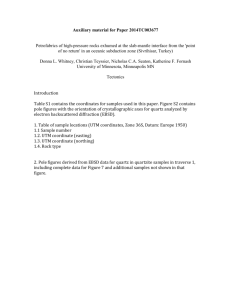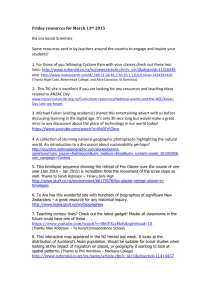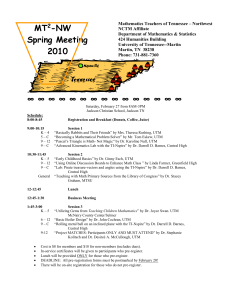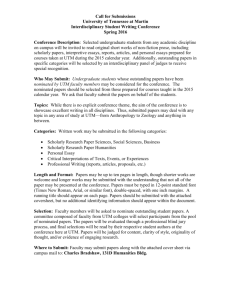click here to view
advertisement
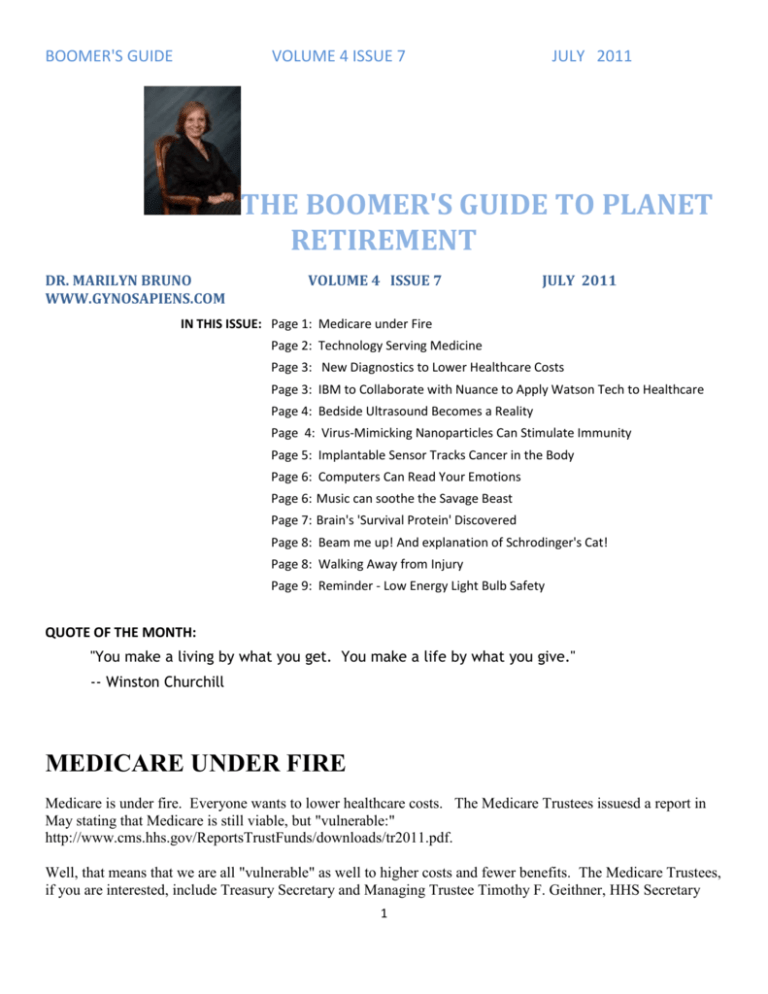
BOOMER'S GUIDE VOLUME 4 ISSUE 7 JULY 2011 THE BOOMER'S GUIDE TO PLANET RETIREMENT DR. MARILYN BRUNO WWW.GYNOSAPIENS.COM VOLUME 4 ISSUE 7 JULY 2011 IN THIS ISSUE: Page 1: Medicare under Fire Page 2: Technology Serving Medicine Page 3: New Diagnostics to Lower Healthcare Costs Page 3: IBM to Collaborate with Nuance to Apply Watson Tech to Healthcare Page 4: Bedside Ultrasound Becomes a Reality Page 4: Virus-Mimicking Nanoparticles Can Stimulate Immunity Page 5: Implantable Sensor Tracks Cancer in the Body Page 6: Computers Can Read Your Emotions Page 6: Music can soothe the Savage Beast Page 7: Brain's 'Survival Protein' Discovered Page 8: Beam me up! And explanation of Schrodinger's Cat! Page 8: Walking Away from Injury Page 9: Reminder - Low Energy Light Bulb Safety QUOTE OF THE MONTH: "You make a living by what you get. You make a life by what you give." -- Winston Churchill MEDICARE UNDER FIRE Medicare is under fire. Everyone wants to lower healthcare costs. The Medicare Trustees issuesd a report in May stating that Medicare is still viable, but "vulnerable:" http://www.cms.hhs.gov/ReportsTrustFunds/downloads/tr2011.pdf. Well, that means that we are all "vulnerable" as well to higher costs and fewer benefits. The Medicare Trustees, if you are interested, include Treasury Secretary and Managing Trustee Timothy F. Geithner, HHS Secretary 1 BOOMER'S GUIDE VOLUME 4 ISSUE 7 JULY 2011 Kathleen Sebelius, Labor Secretary Hilda L. Solis, and Social Security Commissioner Michael J. Astrue. The two public representatives appointed by the president and confirmed by the Senate — Charles P. Blahous III and Robert D. Reischauer. Berwick is designated as Secretary of the Board. Glad we are in such good hands... Well, if Congress and fraud prevention can't lower healthcare costs, maybe Science can. This month's Newsletter is dedicated to the most recent scientific breakthroughs, which I find uplifting and exciting, that may actually lower costs for all of us. Not only is this interesting for us to keep up on the latest, but we actually may benefit from these amazing discoveries in a few years. TECHNOLOGY SERVING MEDICINE Medicine and technology are converging at a fast pace. I came across a reference to the IEEE Engineering in Medicine and Biology Society (EMBS), the world's largest international society of biomedical engineers. Although I still don't know what IEEE stands for, the EMBS' 8,200 members are from 70 countries, doing great things like designing electrical circuits that make a pacemaker run, create the software that gives MRIs readable meaning, etc. etc. Bioinformatics, biotechnology, clinical engineering, information technology, instrumentation and measurement, micro and nanotechnology, radiology and robots should all become part of our vocabulary -- and that of our attending physicians. Here are some of the breakthroughs we are already witnessing: Point of care health care technologies — connecting patients with healthcare professionals via computers. This includes nursing engineering, health monitoring, e-health, and health care information management for disaster situations. Optical imaging technologies — diagnosing and staging cancer, cardiovascular diseases, and other fibrotic diseases. This includes discovery and exploration of naturally existing molecular targets of diseases and the differences associated with the molecular targets between normal and diseased states, as well as diagnosis and treatment. Bioelectronics, bio-nano-sensor technology, and neural engineering — increased knowledge of the nervous system, neurophysiology, and neurological disorders as well as the development of devices to interface with neural tissues. Tissue engineering and regenerative medicine — the advent of stem cell-based therapies, regenerative medicine, and gene therapy. Medical or bio-robots — nano, micro, and macro devices to assist in diagnosis, surgery, prosthetics, rehabilitation and personal assistance. This includes clinical, therapeutic, and surgical applications of medical robots with advanced instrumentation, sensors, actuators, and real-time systems. The following articles give illustrations of these breakthroughs. 2 BOOMER'S GUIDE VOLUME 4 ISSUE 7 JULY 2011 NEW DIAGNOSTICS TO LOWER HEALTHCARE COSTS [+] Doctors can wave this magic wand to eliminate the need for many biopsies to detect skin cancer. University of Rochester researchers have developed an optical technology that provides unprecedented images under the skin’s surface. The aim of the technology is to detect and examine a mole or skin lesion to determine whether they are benign or cancerous without having to cut the suspected tumor out of the skin and analyze it in the lab. Instead, the tip of a roughly one-foot-long cylindrical probe is placed in contact with the tissue, and within seconds a clear, high-resolution, 3D image of what lies below the surface emerges, right in the doctor's office. The device accomplishes this using a unique liquid lens in a process called an optical coherence microscopy. In a liquid lens, a droplet of water takes the place of the glass in a standard lens. As the electrical field around the water droplet changes, the droplet changes its shape and therefore changes the focus of the lens. This allows the device to take thousands of pictures focused at different depths below the skin’s surface. Combining these images creates a fully in-focus image of all of the tissue up to 1 millimeter deep in human skin, which includes important skin tissue structures. Because the device uses near infrared light instead of ultrasounds, the images have a precise, micron-scale resolution instead of a millimeter-scale resolution. Xray vision cannot be far behind. For more on this research: http://www.kurzweilai.net/a-new-highresolution-method-for-imaging-below-the-skin-using-a-liquidlens?utm_source=KurzweilAI+Weekly+Newsletter&utm_campaign=deff2bfdc6-UA-9467421&utm_medium=emailA new high-resolution method for imaging below the skin using a liquid lens IBM to Collaborate with Nuance to Apply Watson Analytics Technology to Healthcare If you missed seeing Watson trounce the humans on Jeopardy a few months ago, you may have another opportunity at your doctor's office. IBM and Nuance Communications, Inc. have announced a research agreement to explore, develop and commercialize the Watson computing system’s advanced analytics capabilities in the healthcare industry within the next 24 months. Additionally, Columbia University Medical Center and the University of Maryland School of Medicine are contributing their medical expertise and research to the collaborative effort to identify the best way that a technology like Watson could interact with medical practitioners to provide the maximum assistance. 3 BOOMER'S GUIDE VOLUME 4 ISSUE 7 JULY 2011 Watson can analyze the meaning and context of human languages, and process information in seconds to provide precise answers to decision makers. For example, a doctor considering a patient’s diagnosis could use Watson’s analytics technology, in conjunction with Nuance’s voice and clinical language understanding solutions, to rapidly consider all the related texts, reference materials, prior cases, and latest knowledge in journals and medical literature to gain evidence from many more potential sources than previously possible. This could help medical professionals more confidently determine the most likely diagnosis and treatment options. I can't wait to see what the medical malpractice attorneys do with this turn of events. For further info on this collaboration: http://www.kurzweilai.net/ibm-to-collaborate-with-nuance-to-apply-watson-analytics-technology-tohealthcare?utm_source=KurzweilAI+Weekly+Newsletter&utm_campaign=deff2bfdc6-UA-9467421&utm_medium=email BEDSIDE ULTRASOUND BECOMES A REALITY Ultrasound imaging uses the same sonar developed for ships at sea. As sound passes through the body it produces echoes, which can identify the distance, size and shape of objects inside. During an examination, a machine called a transducer is used to view an organ and produce pictures. The transducer emits sound and detects the returning echoes when it is placed on or over the body part being studied. Clinicians have often referred to ultrasound technology as the “stethoscope of the future,” predicting that as the equipment shrinks in size, it will one day be as common at the bedside as that trusty tool around every physician’s neck. According to a new report in The New England Journal of Medicine, that day has arrived. The use of ultrasound has moved beyond traditional specialties like radiology and is now being routinely employed by clinicians across myriad medical specialties and practice areas -- and even locations, from Mount Everest to the international space station and in battlefield situations. The biggest growth in the use of ultrasound has been among non-radiologists over the past two decades. The equipment used in ultrasonography—a safe, effective and non-invasive form of imaging that aids in diagnosis and guides procedures—has become more compact, higher quality and less expensive, leading to the growth of "point-of-care" ultrasonography, which is performed and interpreted by the clinician at the bedside. Some medical schools are training students to use ultrasound before they choose a specialty, an indication of its versatility as a diagnostic tool. Virus-Mimicking Nanoparticles can Stimulate Long-Lasting Immunity This is good news for our burgeoning global population that could succumb to bird flu and other pandemics. Vaccine scientists say their “Holy Grail” is to stimulate immunity that lasts for a lifetime. For example, one injection of the live viral yellow fever vaccine, developed in the 1930s by Nobel Prize winner Max Theiler, can protect against disease-causing forms of the virus for decades. But scientists have remained in the dark as to how they induce long lasting immunity. 4 BOOMER'S GUIDE VOLUME 4 ISSUE 7 JULY 2011 Scientists at the Emory Vaccine Center have designed tiny nanoparticles that resemble viruses in size and immunological composition and that induce lifelong immunity in mice. They designed the particles to mimic the immune-stimulating effects of one of the most successful vaccines ever developed – the yellow fever vaccine. . The nanoparticles, made of biodegradable polymers, have components that activate two different parts of the innate immune system and can be used interchangeably with material from many different bacteria or viruses. These particles could provide an instant way to stretch scarce supplies when access to viral material is limited, such as pandemic flu or during an emerging infection. In addition, there are many diseases, such as HIV, malaria, tuberculosis and dengue, that still lack effective vaccines, where this type of immunity enhancer could play a role. The FDA has approved for human use each of the nanoparticles' components individually: MPL (monophosphoryl lipid A, which is contained in the cervical cancer vaccine and is a component of bacterial cell walls), and imiquimod, (a chemical that mimics the effects of viral RNA). In mice, the particles can stimulate production of antibodies to proteins from flu virus or anthrax bacteria several orders of magnitude more effectively than any known vaccines, and the immune cells persist in lymph nodes for at least 18months, almost the lifetime of a mouse. In experiments with monkeys, nanoparticles with viral protein could induce robust responses greater than five times the response induced by a dose of the same viral protein given by itself, without the nanoparticles. For more on this research: http://www.kurzweilai.net/virus-mimicking-nanoparticles-canstimulate-long-lasting-immunity?utm_source=KurzweilAI+Weekly+Newsletter&utm_campaign=deff2bfdc6-UA-9467421&utm_medium=email When designing a vaccine, scientists try to provoke at least one of the human body’s two major players in the immune response: T cells, which attack body cells that have been infected with a pathogen; or B cells, which secrete antibodies that target viruses or bacteria present in the blood and other body fluids. For diseases in which the pathogen tends to stay inside cells, such as HIV, a strong response from a type of T cell known as “killer” T cell is required. The best way to provoke these cells into action is to use a killed or disabled virus, but that cannot be done with HIV because it’s difficult to render the virus harmless. To get around the danger of using live viruses, researchers are working on synthetic vaccines for HIV and other viral infections such as hepatitis B. They are also building on nanotechnology research to design a new type of nanoparticle in concentric fatty spheres that safely carries synthetic vaccines into the target cells. These synthetic particles elicit a strong immune response — comparable to that produced by live virus vaccines — but much safer. This is working in mice for HIV, malaria and, hopefully, cancer. For more on this progress: http://www.kurzweilai.net/nano-sizedvaccines?utm_source=KurzweilAI+Weekly+Newsletter&utm_campaign=deff2bfdc6-UA-9467421&utm_medium=email Implantable sensor tracks cancer in the body Researchers led by Michael Cima at MIT have developed a tumor-tracking capsule small enough to fit inside a needle to implant in the body during a biopsy. Magnetic nanoparticles fill the capsule’s hollow interior, each 5 BOOMER'S GUIDE VOLUME 4 ISSUE 7 JULY 2011 carrying a few monoclonal antibodies (proteins engineered to bind to molecules of interest, such as human chorionic gonadotrophin (hCG), a hormone that tumor cells overproduce in testicular and ovarian cancers). A semi-permeable membrane allows molecules to flow into the capsule, but prevents the nanoparticles from drifting out. To read the device and evaluate whether a nearby tumor is receding or growing, doctors use an MRI scan to detect clusters of cancer-related molecules within the device. This is working in mice injected with human cancer cells, and has also been used to measure the severity of damage from heart attacks induced in mice. For more on this breakthrough: http://www.kurzweilai.net/implantable-sensor-tracks-cancer-in-thebody?utm_source=KurzweilAI+Weekly+Newsletter&utm_campaign=6e887d8c80-UA-9467421&utm_medium=email COMPUTERS CAN READ YOUR EMOTIONS With the emergence of new tools that can measure a person’s mental and physiological states, computer interfaces are starting to focus on how users feel to help computers cater to their needs. Design Interactive is prototyping Next Generation Interactive Systems, or NexIS, a system that will place biological sensors on soldiers. If a sensor detects that a soldier’s pulse is weakening, or determines another problem with her physical state, the system might call for help or administer adrenaline. The company is also developing a system using electroencephalography, eye tracking, and heart-rate monitoring to assess the performance of baggage screeners. Sensors can already detect when a driver is drowsy, distracted, overloaded, or engaged, and could determine other states, such as frustration in computer users. I hope their first tests are on air traffic controllers.... For more on this research: http://www.kurzweilai.net/computers-get-in-touch-with-youremotions?utm_source=KurzweilAI+Weekly+Newsletter&utm_campaign=deff2bfdc6-UA-9467421&utm_medium=email Music training may provide lifelong boost in brain functioning Prevention is worth a pound of cure, and prevention is even more valuable when dealing with incurable diseases, such as Alzheimer's. Researchers at the University of Kansas Medical Center have found evidence suggesting that studying a musical instrument, which requires years of practice and learning, may create alternate connections in the brain that could compensate for cognitive decline as we get older. 6 BOOMER'S GUIDE VOLUME 4 ISSUE 7 JULY 2011 The study recruited 70 healthy adults age 60 to 83 who were divided into groups based on their levels of musical experience. The three groups of study participants included individuals with no musical training; with one to nine years of musical study; or with at least 10 years of musical training. All of the participants had similar levels of education and fitness and didn’t show any evidence of Alzheimer’s disease. All of the musicians were amateurs who began playing an instrument at about 10 years of age. More than half played the piano while approximately a quarter had studied woodwind instruments such as the flute or clarinet. Smaller numbers performed with stringed instruments, percussion, or brass instruments. The high-level musicians who had studied the longest performed the best on cognitive tests, followed by the low-level musicians and non-musicians, revealing a trend relating to years of musical practice. The high-level musicians had statistically significant higher scores than the non-musicians on cognitive tests relating to visuospatial memory, naming objects, and cognitive flexibility (the brain’s ability to adapt to new information). The brain functions measured by the tests typically decline as the body ages and more dramatically deteriorate in neurodegenerative conditions such as Alzheimer’s disease. The results suggest a “strong predictive effect of high musical activity throughout the lifespan on preserved cognitive functioning in advanced age,” the researchers concluded. For more on this research: http://www.kurzweilai.net/music-training-may-provide-lifelong-boost-in-brainfunctioning?utm_source=KurzweilAI+Weekly+Newsletter&utm_campaign=54cc81525e-UA-9467421&utm_medium=email Brain's ‘Survival Protein’ Discovered A “survival protein” that protects the brain against the effects of stroke in rodent brain tissue has been discovered by scientists at Johns Hopkins University. The finding has implications for treating stroke as well as Parkinson’s Disease, diabetes, and heart attack. When brain tissue is subjected to a stressful but not lethal trauma, a defense response occurs that protects cells from subsequent traumas. The scientists tracked this preconditioning pathway to identify the most critical molecular players, including a protein called "Iduna." This protein increased three- to four-fold in preconditioned mouse brain tissue following a trauma to the tissue. The scientists found that the Iduna protein interferes with a particular kind of cell death that’s implicated in complications from diabetes and heart attack as well as stroke. Iduna prevents the movement of cell-deathinducing factor (AIF) into a cell’s nucleus. This protective response is broad in its defense of neurons and glia and blood vessels — the entire brain. It’s not just a delay of brain damage and death, but real protection that lasts for about 72 hours. Beam Me Up: Quantum Teleporter Breakthrough Here is an article guaranteed to challenge anyone's brain. 7 BOOMER'S GUIDE VOLUME 4 ISSUE 7 JULY 2011 Researchers at the University of South Wales have achieved a breakthrough in quantum communications and computing using a "teleporter" and wave packets of light. The experiment, conducted in the Department of Applied Physics in the University of Tokyo, is the first transfer or “teleportation” (destroyed in one place and recreated in another one) of a particular complex set of quantum information from one point to another. Sounds like last year's commercials for Comcast High Speed Internet. But, this is not for transmitting your Mom and Pop computer files. This is for high-speed, high-fidelity transmission of large volumes of information, such as quantum encryption keys, via quantum communications networks. Yikes. We geezers have to get up to speed on this one. Get ready for some more mind-blowing concepts: the researchers say that the oscillation has "two opposite phases" at the same time -- being and non-being. I won't go into what this means, but scientists describe the results as being like a "famous" conundrum known as Schrodinger’s Cat. When I read this, I had no idea what they were talking about. After Felix, Sylvester, Top Cat, and Garfield, who was this celebrity Schrodinger's Cat? I googled Schrodinger's Cat and came up with more mind blowing explanations If you want to have your mind blown, check out: http://www.kurzweilai.net/schrodingerscat?utm_source=KurzweilAI+Weekly+Newsletter&utm_campaign=54cc81525e-UA-9467421&utm_medium=email And, as long as we are letting our imaginations run wild, all of this high speed stuff may some day be accessible from an ‘imaginary phone’ in the palm of your hand. Researchers at Potsdam University in Germany have developed a camera with a motion-sending transmission system to send a gesture to a computer that processes it and then sends the relevant command to your cell phone. This would be terrific for people like me who can never find my cell phone, unless it is clipped to my body. The handicapped use imaginary phones as a shortcut to operate physical phones in their pockets, to activate a buzzer if you have "fallen and can't get up," etc. The researchers envision integrating the camera into clothing, such as a brooch, pendant, or button of a shirt. The researchers are also working on replacing a TV remote control with an imaginary zapper. WALKING AWAY FROM INJURY You may have seen this on TV. After unveiling the world’s first robotic legs last year, Auckland-based company Rex Bionics has made its first sale to Dave MacCalman, a New Zealand Paralympian. I like the idea of the Roomba, but I really like the idea of robotics helping us to overcome physical handicaps. The custom-fitted, motorized robotic exoskeleton allowed Dave, who sustained a spinal cord injury diving into a river while in the United States on a basketball scholarship, to take his first steps in more than 30 years. Dave captained the 1992 New Zealand Paralympic team to Barcelona and holds the current World Record for quadriplegic pentathlon. Nothing like hearing directly from Dave about this terrific technologic breakthrough: “It is hard to describe what it has been like to be back on my feet again. I’m six-foot-four so it’s been amazing to experience life from 8 BOOMER'S GUIDE VOLUME 4 ISSUE 7 JULY 2011 that height again. I’m looking forward to taking my Rex home and being able to stand around and socialize with family and friends.” Wow. Other motorized exoskeletons have been developed since 2010. One was recently developed by a U.S. university, allowing a student to get up and walk over to receive his diploma. I am delighted that scientists have finally caught up with Hollywood. After all, we have seen Iron Man and other super heroes don body suits in order to fly, lift heavy weights, leap tall buildings in a single bound, etc. It is terrific to give mobility to people without limbs or the ability to control them. For more on this reasearch: http://www.kurzweilai.net/newzealand-quadriplegic-dons-robotic-exoskeleton-and-walksagain?utm_source=KurzweilAI+Weekly+Newsletter&utm_campaign=5dba75cd55-UA-9467421&utm_medium=email And, taking this one step further, there is Rob Summers, 25, a pitcher for Oregon State University who was totally paralyzed below the chest five years ago after being struck by a vehicle in a hit-and-run accident, and can now stand on his own for up to four minutes at a time — without support — and up to 25 minutes with assistance provided only for balance. Instead of an exoskeleton, scientists at the University of Louisville, UCLA, and the California Institute of Technology found a way to "teach" Rob's spinal cord itself, which still has plasticity, to control his legs without direct control from the brain. The research could also lead to treatments for motor or sensory injuries, paralysis, Parkinson’s disease and stroke. Aided by a harness support and some therapist assistance, Summers can make repeated stepping motions on a treadmill. He can also voluntarily move his toes, ankles, knees, and hips on command. The results were achieved through continual, low level, direct “epidural electrical stimulation” of Rob's lower spinal cord, mimicking signals the brain normally transmits to initiate movement. Once that signal is given, the spinal cord’s own neural network, combined with the sensory input derived from the legs to the spinal cord, is able to direct the muscle and joint movements required to stand and step, with assistance, on a treadmill. The stimulation does not induce the movement. It modulates the activity level of the spinal neural network. The spinal cord can interpret the sensory information from the leg, even though the individual may not be able to The researchers say they envision a day when at least some individuals with complete spinal cord injuries, Parkinson's or stroke, will be able to use a portable stimulation unit and, with the assistance of a walker, stand independently, maintain balance and execute some effective stepping. Relief from secondary complications of complete spinal cord injury — including impairment or loss of bladder control, sphincter control and sexual response — could prove to be even more significant. The research was funded by the Christopher and Dana Reeve Foundation (true Super Heroes) and the National Institutes of Health. For more on this research, including a 9 minute video: http://www.kurzweilai.net/research-breakthroughallows-paraplegic-man-to-stand-on-hisown?utm_source=KurzweilAI+Weekly+Newsletter&utm_campaign=bf9c2667e2-UA-9467421&utm_medium=email REMINDER - LOW ENERGY LIGHT BULB SAFETY 9 BOOMER'S GUIDE VOLUME 4 ISSUE 7 JULY 2011 Just a reminder on safety precautions to follow in the event a low energy light bulb (CFL) breaks: Disposal of low energy light bulbs -- Low energy light bulbs are classified as Waste Electronic or Electrical Equipment (WEEE) and therefore must never be disposed of to landfill. -- Manufacturers of CFLs have to pay for their treatment and recycling and therefore a retailer should inform the customer of the disposal arrangements upon request: either return to store for recycling or take to the nearest designated collection facility. Cleaning up a broken low energy light bulb -- As with any mercury spill, if a bulb becomes broken, the room should be vacated and ventilated for 15 minutes. -- Do not use a vacuum cleaner – but wearing rubber gloves, use a dust pan and brush to sweep up all particles and glass fragments. This will also avoid the risk of glass cuts. Light strokes should be used, and try to avoid inhaling airborne dust. -- The glass fragments, gloves, dustpan and brush should be placed in a plastic bag. -- Wipe the area with a damp cloth, then add that to the bag and seal it. -- Place the sealed plastic bag in a cardboard box, marked as containing hazardous waste and broken glass. -- The cardboard box should not be disposed of in the normal waste collection. -- Return to the store for recycling or to the location or take to the nearest designated collection facility. Please let me know how topics you would like covered in our next Newsletters! E-mail:DrBruno@gynosapiens.com. All previous Newsletters are posted online on the homepage of www.gynosapiens.com 10

